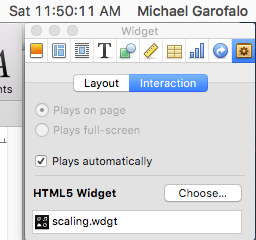I'm confused. How are you displaying the widget icon in iBooks? Do you mean the default image? If that's what you mean, then you can just set the Widget to play automatically.

It sounds like you're building a level select. The first scene in Hype can be the level select – which is automatically updated by the local storage value.
localStorage.stars=stars;
So if "stars" equals 1, then it goes to frame 1 or scene 1. If it equals 2, then it goes to frame 2 or scene two.
I tested it out in A Book About Hype. It's an iBook that uses widgets created with Hype. Now one of my examples should have savable high scores.